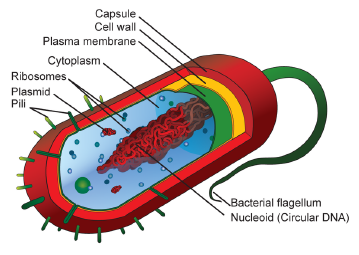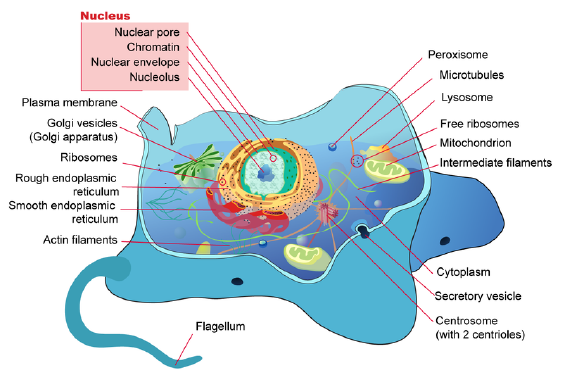Reading: Prokaryotic and Eukaryotic Cells
Douglas Wilkin, Ph.D.
Jean Brainard, Ph.D.
http://www.ck12.org/saythanks
• Give examples of prokaryotic and eukaryotic cells.
• Compare and contrast prokaryotic and eukaryotic cells.
How many different types of cells are there?
There are many different types of cells. For example, in you there are blood cells and skin cells and bone cells and even bacteria. Here we have drawings of bacteria and human cells. Can you tell which depicts various types of bacteria? However, all cells - whether from bacteria, human, or any other organism - will be one of two general types. In fact, all cells other than bacteria will be one type, and bacterial cells will be the other. And it all depends on how the cell stores its DNA.
Two Types of Cells
There is another basic cell structure that is present in many but not all living cells: the nucleus. The nucleus of a cell is a structure in the cytoplasm that is surrounded by a membrane (the nuclear membrane) and contains DNA. Based on whether they have a nucleus, there are two basic types of cells: prokaryotic cells and eukaryotic cells.
Prokaryotic Cells
Prokaryotic cells are cells without a nucleus. The DNA in prokaryotic cells is in the cytoplasm rather than enclosed within a nuclear membrane. Prokaryotic cells are found in single-celled organisms, such as bacteria, like the one shown in Figure 1.1. Organisms with prokaryotic cells are called prokaryotes. They were the first type of organisms to evolve and are still the most common organisms today.

FIGURE 1.1
Prokaryotic Cell. This diagram shows the structure of a typical prokaryotic cell, a bacterium. Like other prokaryotic cells, this bacterial cell lacks a nucleus but has other cell parts, including a plasma membrane, cytoplasm, ribosomes, and DNA. Identify each of these parts in the diagram.
Eukaryotic Cells
Eukaryotic cells are cells that contain a nucleus. A typical eukaryotic cell is shown in Figure 1.2. Eukaryotic cells are usually larger than prokaryotic cells, and they are found mainly in multicellular organisms. Organisms with eukaryotic cells are called eukaryotes, and they range from fungi to people.
Eukaryotic cells also contain other organelles besides the nucleus. An organelle is a structure within the cytoplasm that performs a specific job in the cell. Organelles called mitochondria, for example, provide energy to the cell, and organelles called vacuoles store substances in the cell. Organelles allow eukaryotic cells to carry out more functions than prokaryotic cells can. This allows eukaryotic cells to have greater cell specificity than prokaryotic cells. Ribosomes, the organelle where proteins are made, are the only organelles in prokaryotic cells.
In some ways, a cell resembles a plastic bag full of Jell-O. Its basic structure is a plasma membrane filled with cytoplasm. Like Jell-O containing mixed fruit, the cytoplasm of the cell also contains various structures, such as a nucleus and other organelles.
Summary
• Prokaryotic cells are cells without a nucleus.
• Eukaryotic cells are cells that contain a nucleus.
• Eukaryotic cells have other organelles besides the nucleus. The only organelles in a prokaryotic cell are ribosomes.

FIGURE 1.2
Eukaryotic Cell. Compare and contrast the eukaryotic cell shown here with the prokaryotic cell. What similarities and differences do you see?
Review
1. What is the cell nucleus?
2. What is the main difference between prokaryotic and eukaryotic cells?
3. Give an example of a prokaryotic cell.
4. Define organelle.
5. What is the advantage of having organelles?
